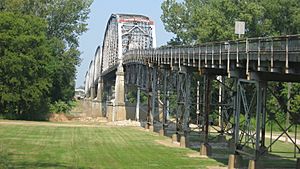New Harmony Toll Bridge facts for kids
Quick facts for kids New Harmony Toll Bridge |
|
|---|---|

Southern side of the Indiana end
|
|
| Coordinates | 38°07′51″N 87°56′29″W / 38.13090°N 87.9415°W |
| Carries | Illinois Route 14/Indiana State Road 66 |
| Crosses | Wabash River |
| Locale | New Harmony, Indiana |
| Maintained by | White County Bridge Commission |
| Characteristics | |
| Design | Riveted, Parker through truss |
| Material | steel |
| Total length | 2,579 feet (786 m) |
| Width | 20 feet (6.1 m) |
| Number of spans | 47 |
| History | |
| Closed | May 21, 2012 |
The New Harmony Toll Bridge, also known as the Harmony Way Bridge, is a two-lane bridge that is now closed. It crosses the Wabash River. This bridge connects Illinois Route 14 with Indiana State Road 66. This road is also known as Church Street in New Harmony, Indiana.
The bridge links White County, Illinois with Posey County, Indiana. It used to carry U.S. Route 460 from 1947 until 1974. That highway was later removed from the road system in Illinois and Indiana. The bridge has four main sections. The White County Bridge Commission owns it. It was built in 1930 by the Big Wabash Bridge Company. This company was from Carmi, Illinois, and built the bridge without money from the government. The next bridge downstream is about 15 miles (24 km) away. It is called the Wabash Memorial Bridge near Mount Vernon, Indiana. The next bridge upstream is for Interstate 64, but farm vehicles cannot use it.
Building the Bridge
The New Harmony Toll Bridge is 2,579 feet long. That's almost half a mile! It has 47 sections and a concrete road that is 20 feet wide. This bridge was the first highway bridge built across the lower part of the Wabash River. It is also the oldest bridge still standing over the Wabash River in Illinois and half of Indiana.
A private company, the Big Wabash Bridge Company, first owned the bridge. This company was given permission by Congress to build and run the bridge in 1928. They hired the Nashville Bridge Company to build it. The bridge officially opened on December 21, 1930. About 10,000 people came to celebrate the bridge's opening on December 30, 1930. In 1941, Congress created the White County Bridge Commission. This group was formed by both Illinois and Indiana. They bought the bridge from the Big Wabash Bridge Company for $895,000.
Bridge Operations
About 900 vehicles crossed the bridge every day. The bridge collected about $30,000 each month from tolls. Its monthly costs were around $22,000. In 2007, the bridge was added to the National Register of Historic Places. This was partly because of its connection to historic New Harmony, Indiana. Its age also played a role.
In 1951, a new toll booth was built on the western side of the river. This replaced an older one on the eastern side. In 1994, the bridge surface was coated with a special material. However, this coating did not work well. The company that owned the bridge refused to pay the contractor. After a legal case, the bridge commission had to pay.
Bridge Repairs and Closure
From September 2007 to April 2008, the bridge was closed to all traffic. This happened because cracks appeared in some of its concrete supports. During this time, workers added new supports to the existing ones. They also made other necessary repairs. In 2010, engineers checked the bridge again. They found that it needed another $6 million in repairs. The National Bridge Inventory, which checks bridges, called it "Structurally Deficient." This means it was not in good shape.
On May 21, 2012, it was announced that the bridge would close for good. It was supposed to close on May 29, 2012. However, a member of the White County Bridge Commission, Jim Clark, decided to close it sooner. He said the cost to fix the bridge was too high. After getting a full report from engineers, he knew it had to close right away. "Once I saw their weight-load calculations, I knew we had to shut it down right away," Clark said.
The bridge closed immediately after he received the report. The thirteen people who worked at the toll booth lost their jobs. When the bridge closed, there were still many unused toll tickets. People could get refunds for these tickets for 30 days. The closure of the New Harmony Bridge had a big impact. It especially affected farmers and the oil industry in the area. The closure made the drive between New Harmony and Crossville, Illinois about ten miles longer.
Notes


